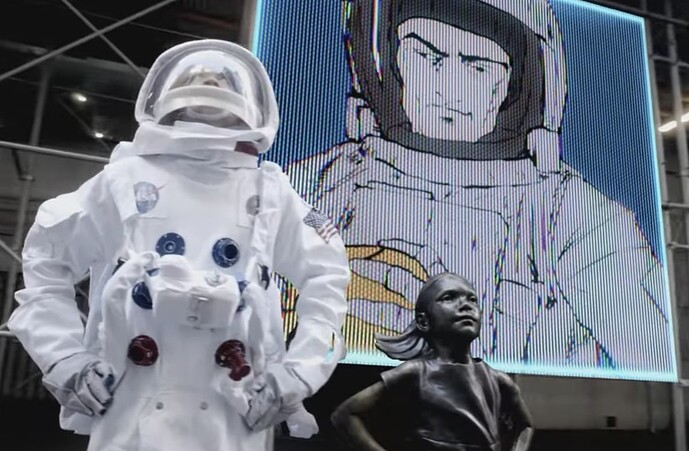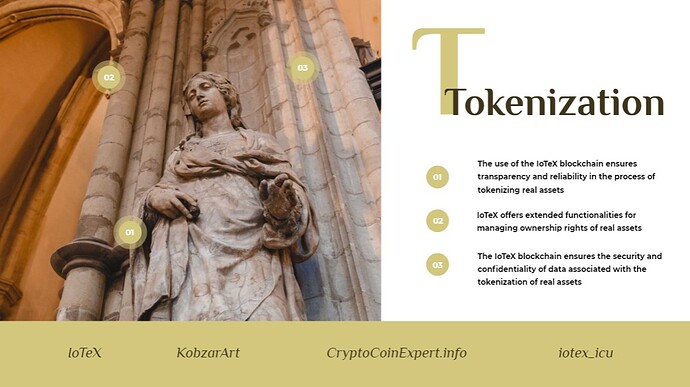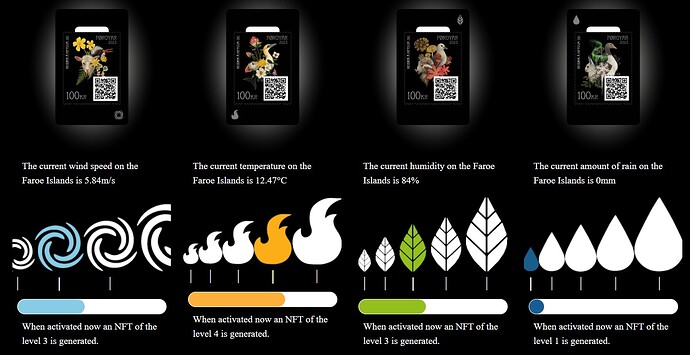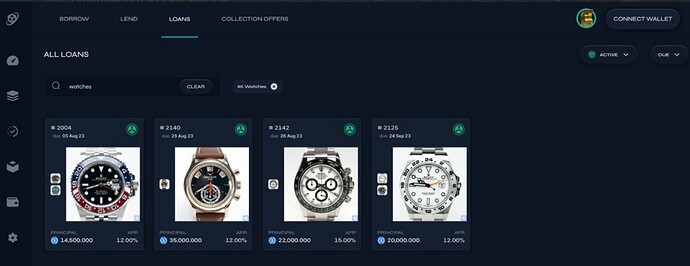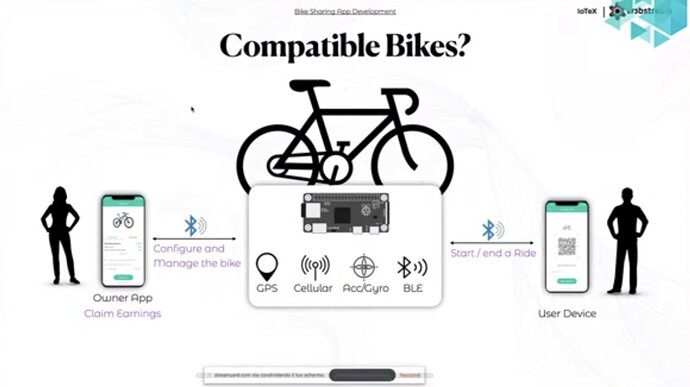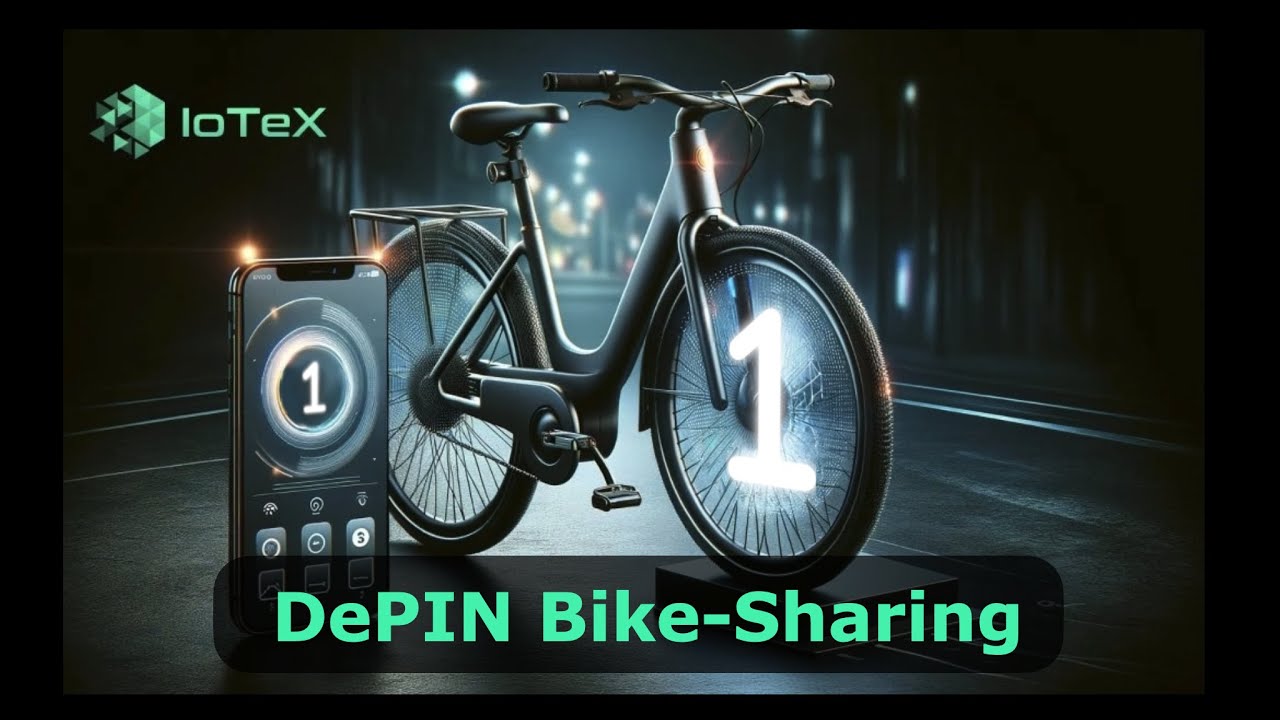Hi. My work is related to tokenization of real assets. Now one of my activities is to develop a solution to transfer the ownership of a real object using NFT. There is still a lot of work ahead of me and my team, but progress is already being made. I am wondering if anyone in the IoTeX community is doing similar work? I see one of the problems associated with transferring ownership of a real object as marking a real object with a reliable and trustworthy device. In theory you could use Pebble, but in my case this tracker is not suitable. I need to mark small-sized works of art created in a single copy, so I need another solution. Maybe there are people on this forum who are also interested in solving the problem of tokenization of real assets using the IoTeX blockchain network. I would be happy to participate in the discussion and work together.
Hello, BitMet. Thank you for creating this thread for discussions. I will share some of my thoughts here.
To tokenize real assets and transfer ownership rights using NFTs (Non-Fungible Tokens), we can follow the following approach:
-
Asset Identification: Determine the specific real asset we want to tokenize, such as real estate, artwork, or collectibles. There is already a demand for tokenizing these types of assets. Additionally, we have a large collection of artworks that need to be tokenized.
-
NFT Creation: Utilize a platform for NFT creation, such as the IoTeX or Ethereum blockchain, to create a unique token representing the real asset. This token will contain information about ownership rights and asset characteristics. I have read about the Mimo finance planning to create an NFT marketplace, but I have yet to see this marketplace.
-
Establishing Rules: Define rules and conditions associated with the token. For example, rules regarding asset usage, resale, or earning income from the asset can be set. Our legal team is already working on this.
-
Transaction Execution: Offer NFT tokens on the market or through an NFT exchange platform. Potential buyers can purchase the token and become owners of the corresponding real asset. There is a proposal from the Pi-Protocol team on this forum outlining the mechanism for turning NFTs into financial assets for passive income generation. I am not advertising this project, there is no development in it right now, but I liked their idea.
-
Transfer of Ownership: After the transaction is completed, the buyer will receive ownership rights to the real asset represented by the NFT token. This is officially confirmed by blockchain records and the token itself. Our legal team is currently addressing this issue. We have no concerns with artwork, but there are some questions to be resolved regarding real estate.
As IoTeX aims to become a leader in connecting the real world to Web3, tokenizing real assets and utilizing NFTs opens up new pathways for integrating the physical world into the digital space, enhancing efficiency, accessibility, and asset utilization. However, the question remains: How can we effectively label a real asset (such as artwork) to connect it with Web3?
Tokenization of real assets represents an innovative approach to the financial system, opening up new opportunities for efficient asset management and increased accessibility for investors. These news and analytical reviews demonstrate the growing interest in tokenization and its potential advantages.
Review of Tokenization of Real Assets:
![]() The Hong Kong Monetary Authority (HKMA) has announced the launch of the e-HKD pilot program, in which 16 financial, payment, and technology companies will participate in the first round of pilot projects for 2023. The program aims to explore potential use cases in six categories, including full payments, programmable payments, autonomous payments, tokenized deposits, Web3 transaction settlements, and calculations involving tokenized assets. Learn more: [link]
The Hong Kong Monetary Authority (HKMA) has announced the launch of the e-HKD pilot program, in which 16 financial, payment, and technology companies will participate in the first round of pilot projects for 2023. The program aims to explore potential use cases in six categories, including full payments, programmable payments, autonomous payments, tokenized deposits, Web3 transaction settlements, and calculations involving tokenized assets. Learn more: [link]
![]() Over the past few years, Decentralized Autonomous Organizations (DAOs) have invested over $1.4 billion in real-world assets. This article analyzes the three largest DeFi protocols and their investments in traditional real assets. Learn more: [link]
Over the past few years, Decentralized Autonomous Organizations (DAOs) have invested over $1.4 billion in real-world assets. This article analyzes the three largest DeFi protocols and their investments in traditional real assets. Learn more: [link]
![]() Citi forecasts that the value of tokenized assets will reach $4 trillion by 2030. This analysis provides insights into the development of asset tokenization and the growth of their value. Learn more: [link]
Citi forecasts that the value of tokenized assets will reach $4 trillion by 2030. This analysis provides insights into the development of asset tokenization and the growth of their value. Learn more: [link]
By linking physical devices (assets) to tokens on the IoTeX blockchain, it is possible to establish the uniqueness and identification of each device, ensuring data integrity and authenticity. This helps prevent falsification and manipulation of IoT data, as well as fosters trust among network participants. In our upcoming posts, we will continue discussing the topic of tokenization of real assets. Join us for further discussions.
Hello everyone! This is Yulya, and I want to share my perspective on the tokenization of real assets, especially artworks. Although I, as a woman, don’t have much technical knowledge, I have seen tremendous potential in this field. I have already experimented with augmented reality applications and created artworks using artificial intelligence. Today, I observe how artificial intelligence is transforming our world and creating astonishing things. However, genuine artworks created by human hands continue to be highly valued by collectors. I am confident that in the future, the gap in value between generative art and human creations will only increase. Therefore, the tokenization of real assets holds immense significance for the authenticity and evaluation of real artworks.
Now, let me supplement the text with some facts:
-
IoTeX provides a blockchain platform with advanced capabilities for tokenizing real assets. This enables the creation of unique NFT tokens that represent real artworks with authentic information about them.
-
The use of the IoTeX blockchain ensures transparency and reliability in the process of tokenizing real assets. Each token has its unique identification and is recorded in an immutable blockchain, ensuring indisputable ownership.
-
IoTeX offers extended functionalities for managing ownership rights of real assets. This includes setting usage rules, resale possibilities, and generating income from the assets.
-
The IoTeX blockchain ensures the security and confidentiality of data associated with the tokenization of real assets. The system employs cryptographic methods and privacy mechanisms, making the tokenization process secure and protected.
-
IoTeX actively develops integration with other blockchain platforms and NFT marketplaces, creating more opportunities for trading and exchanging tokens, as well as expanding their accessibility to a wider audience.
By using the IoTeX network for the tokenization of real assets, we can transfer the uniqueness and value of real artworks into the digital space, providing new possibilities for collecting, trading, and ensuring authenticity. I’m looking forward to hearing your thoughts and opinions on this!
Hello! Tokenization of real assets opens up the opportunity for fractional ownership in several aspects. Here are a few reasons:
-
Accessibility: Tokenization allows real assets to be divided into fractional shares that can be sold to investors. This means that people with different financial positions can acquire shares of assets that were previously inaccessible to them. Thus, tokenization expands the pool of potential investors and makes investments more accessible.
-
Liquidity: Tokens representing real assets can be easily bought, sold, and traded on various platforms. This creates the opportunity for investors to quickly and efficiently buy and sell shares of assets in real-time. As a result, fractional investors enjoy greater liquidity of their assets.
-
Portfolio diversification: Tokenization of real assets enables investors to create a diversified portfolio that includes various types of assets. For example, an investor can acquire shares in real estate, artworks, and collectibles, thereby allocating their investments across different asset classes. This helps to reduce risks and increase the potential returns on investments.
-
Transparency and verification: Through the use of blockchain technology, tokenization of real assets ensures transparency and verification of ownership. Every transaction and transfer of ownership is recorded on the blockchain, making the process more transparent and reliable for investors. It also helps to establish the authenticity of assets and prevent fraud.
Thus, tokenization of real assets creates new opportunities for fractional ownership, expanding accessibility, liquidity, and diversification of investment portfolios. In this topic, myself and my colleagues are discussing the benefits and implications of this innovative approach. Feel free to join the conversation and share your thoughts!
Hi. You have started an interesting topic, but it seems to me that at the moment the topic of tokenization of real assets is not relevant and there are still many problematic issues to overcome before its mass adoption.
Everyone says that in WEB3 assets belong only to me and only I dispose of them, but it’s not true. Now the WEB3 infrastructure on the user side is often very poorly protected.
Every day I read in different chats the problems of crypto-assets users, everywhere the same problems: “my wallet was hacked”, “I lost my wallet’s syster”, “intruders stole my coins”, “a vulnerability was found in the blockchain network”, and other. Without addressing these basic user/investor issues, tokenization of real assets is an easy way to lose a real asset.
What do you have to say about this?
Hi Kristina, thank you for raising the issues in your post. I understand your concerns regarding the tokenization of real assets and the problems associated with security and Web3 infrastructure. Indeed, there are risks and vulnerabilities that users face at the moment, such as wallet hacks and asset loss. The cryptocurrency market is volatile, and as you know, personally, I’ve only lost money in crypto, while I earn solely from software development.
It’s important to understand that tokenization of real assets and Web3 technologies are in an active development stage. In the future, we can expect improvements in security and the emergence of innovative solutions that will mitigate risks and provide reliable asset protection for users.
Many projects and teams are working on enhancing security and developing new protocols that will make Web3 usage more secure and convenient. Cryptographic methods, multi-signatures, security audits, and improved wallets are some of the measures being taken to safeguard users’ assets.
For users, it’s crucial to exercise caution and implement appropriate security measures when dealing with crypto assets. This includes choosing reliable wallets, installing reputable applications, keeping software up to date, utilizing two-factor authentication, and maintaining backup copies of information. Much information has already been written about this, but users still need constant reminders.
Overall, tokenization of real assets has the potential to transform financial markets and create new opportunities for investors. However, security and asset protection are key issues that need to be addressed to ensure trust and widespread adoption of this technology. That’s precisely what I’m currently working on in my job.
Hi, I read a long-awaited announcement on Twitter today stating that the NFT trading platform with real assets and DePin assets will be launched on June 27, 2023. This is good news. Really looking forward to getting clarification from the @mimo team on this forum
Hi, my thoughts on investing in tokenized real assets. Investing in tokenized real assets can be an additional strategy to consider when aiming to become a millionaire before retirement. Tokenization involves representing real-world assets, such as real estate, artwork, or commodities, as digital tokens on a blockchain.
Diversification: Investing in tokenized real assets allows you to diversify your investment portfolio beyond traditional asset classes like stocks and bonds. By adding tokenized real assets to your portfolio, you can potentially benefit from the performance and growth of different sectors, reducing the risk associated with a single asset class.
Accessibility: Tokenization opens up opportunities to invest in previously inaccessible or illiquid assets. For example, you can own fractional shares of high-value properties or valuable artwork that would otherwise require significant capital. This accessibility provides the potential for broader investment options and exposure to different asset classes.
Global Market Exposure: Tokenization enables investments in assets from around the world without geographical limitations. This global market exposure can offer opportunities to tap into emerging markets or sectors that show potential for growth, increasing the likelihood of higher returns on investment.
Enhanced Liquidity: Tokenization can improve liquidity by allowing fractional ownership and facilitating peer-to-peer trading on blockchain-based platforms. This liquidity makes it easier to buy or sell your investment, providing flexibility and potentially reducing transaction costs.
Transparency and Security: Blockchain technology provides transparency and immutability to tokenized assets, reducing the risk of fraud or manipulation. The decentralized nature of blockchain ensures that transaction records and ownership information are secure and accessible to all participants, enhancing trust and accountability in the investment process.
However, it’s important to note that investing in tokenized real assets also carries certain risks:
Regulatory Uncertainty: The regulatory landscape surrounding tokenized assets is still evolving in many jurisdictions. Regulations regarding security tokens, compliance, and investor protection may vary, which could impact the liquidity and transferability of tokenized assets.
Market Volatility: Like any investment, tokenized real assets can be subject to market volatility. Factors such as economic conditions, industry trends, and investor sentiment can influence the value of tokenized assets, potentially leading to fluctuations in returns.
Technological Risks: Tokenization relies on blockchain technology, which is still developing and may face technical challenges or vulnerabilities. It’s crucial to assess the security measures and protocols implemented by the platforms facilitating tokenized asset transactions to mitigate risks associated with hacking or data breaches.
Hello everyone! Tokenization can be applied not only to real assets but also to intellectual property rights.
Tokenizing copyright with the help of NFTs (Non-Fungible Tokens) involves representing and digitally formalizing rights to creative works as unique tokens on the blockchain.
NFTs are a special type of token that are non-interchangeable and possess uniqueness and indivisibility. Each NFT has a unique identifier that confirms its authenticity and ownership of a specific copyrighted work.
The process of tokenizing copyright using NFTs allows authors to protect their intellectual property rights and create a digital record that confirms their ownership and control over the work. An author can create an NFT that represents their work and transfers ownership, sales rights, and usage rights of the work in digital form.
The advantages of tokenizing copyright with NFTs include:
- Confirmation of the authenticity and authorship of the work.
- The ability to establish and automatically enforce rules for the usage of the work.
- The potential for monetizing copyright through NFT sales or earning royalties from subsequent sales.
NFTs with copyright can be sold or transferred to other individuals, opening up new opportunities for artists, musicians, and other content creators. They can receive compensation for their works and maintain control over their usage even after the sale.
I’ve provided a brief overview of the potential tokenization of copyright, but for comprehensive protection of intellectual property, it is necessary to work with legal professionals and establish mechanisms for transferring intellectual property rights. I haven’t personally conducted such work before.
Hi, we all saw the good news yesterday - https://nft.mimo.exchange is up and running. It is a good time for the tokenization of real assets in the iotex blockchain network. Now everyone can tokenize his real asset in the form of NFT and put it up for sale. There is now a marketplace on the iotex network for those wishing to buy tokenized assets. I look forward to testing this marketplace. I want to believe that nft.mimo.exchange will work reliably and without failures.
I saw a great solution in tokenization of a real asset, I suggest we take a close look at it. Everything in this solution is well thought out. Our specialists need to see how everything works in this project and adapt it to our needs.
The launch of the first NFT stamps in Scandinavian countries.
Posta is introducing a new generation of stamps, the so-called NFT stamps. This means that each physical stamp is represented by a unique digital token, known as a non-flammable token ( NFT ), which is stored in a blockchain network. This means that each stamp is truly unique and cannot be reproduced or duplicated.
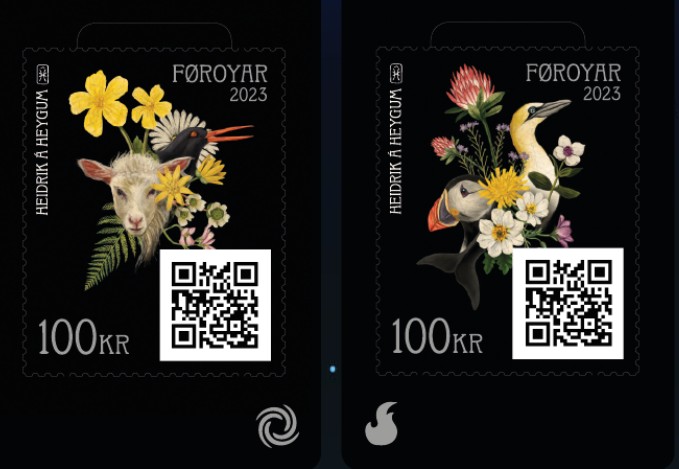
This was achieved by integrating a so called “oracle“ that enables owners to not only influence the visual appearance of their digital NFT stamp, but also to capture a unique moment in time that can never be replicated again. For the first time, owners can take control, not only of their own stamps but also of the availability and rarity values in the market. This feature aims to highlights that our actions are interconnected and individual choices can have a broader impact on the world.
Each postage stamp in this series is protected by an NFC chip.
Near Field Communication (NFC) is a wireless technology standard that enables communication between two devices that are within close proximity of each other. The NFC technology opens up new possibilities for secure and easy verification of physical assets, such as collectibles, artworks, and documents, in a world where the risk of counterfeiting is increasing. With the NFT stamp, we’ve embedded encrypted NFC microchip that lets you verify the authenticity of your NFT stamp, by sending one-time messages that alters with each scan. To use this NFC feature, simply activate the NFC function on your smartphone and hold your Stamp of Maybe close to your device. Your smartphone will detect the NFC chip, and will show you if the stamp is genuine and how often the stamp has been scanned.
The technical side was handled by Variussystems, a software solutions company that developed all the digital content and blockchain integrations for this project.
I’ll add a link to an article about other crypto stam: Post offices adopting NFTs leads to a philately renaissance.
Hi, I read a retweet that @Raullen did today that said: “20,000+ connected devices across 70+ countries on the IoTeX network”.
I was very excited about this news, and I liked the interactive world map that shows the number of connected devices in each country.
I thought tokenized assets might look good on this map. But there is one problem, right now this map shows only superficial statistics, country-number of devices-EXPLORER. This information is very little to properly track the number of devices actually connected. So right now this tool is not suitable for tracking tokenized real assets in the iotex blockchain.
Algorithm for using NFT and real asset as collateral.
This tweet discusses a unique loan transaction where a lender gave a stranger a $35,000 loan using a luxury watch as collateral. The borrower sent the watch to an escrow company, who issued an NFT representing ownership of the watch. The borrower listed the NFT on Arcade and accepted a loan offer. The NFT was transferred to an escrow wallet until the loan term is up or the borrower repays. If the borrower defaults, the lender can claim the watch by burning the NFT. This method allows for global liquidity and potentially better loan rates. The tweet also mentions that this is just the beginning of using NFTs to prove ownership of real-world assets.
Hello everyone! Most likely, you have all already seen this interesting educational video, but I would like to share the link to it in this forum thread. In a live stream for developers, @zimne discussed a decentralized bicycle rental system and shared his thoughts. This video has it all: from exploring the concept of tokenizing real assets using the example of bike rentals to real-time coding examples.
Today, the most important person on the IOTEX team @Raullen launched a Twitter poll:
Real-World Assets (#RWA) are making waves, enabling fractional ownership of real-world assets globally. The catch: off-chain processes require endorsements from traditional financial gatekeepers, which is the weakest link and introduce counterparty risks. How to overcome it?
I find it very interesting to see the responses from respected people in the IOTEX community. I will move the most interesting answers to this thread on the forum.
In turn, I would like to answer your question and offer my vision:
To overcome the challenge of offline processes and approvals from traditional financial intermediaries, blockchain technology and tokenization of real assets can be utilized.
Blockchain technology enables the creation of a decentralized and transparent system for accounting and transactions. Tokenization of real assets, representing them as digital tokens on the blockchain, facilitates easy and secure trading of fractional shares of these assets.
By applying blockchain and NFT (Non-Fungible Token) technology for the tokenization of real assets, the need for reliance on traditional financial intermediaries is eliminated, as all transactions are executed on a public and transparent blockchain. This reduces counterparty risks and enhances trust in transactions.
Blockchain technology also ensures reliable ownership records and transaction transparency, providing the ability to verify the legitimacy and authenticity of real assets represented as tokens.
Hello everyone. I see great potential in tokenizing assets to expand global trade and contemporary art collections. Let me illustrate this with an example.
Let’s say a rare painting is jointly acquired at auction by a consortium of art investors from the US, China and the EU. Instead of complex legal documents dividing ownership, the painting can be tokenized into a fixed number of digital tokens representing ownership shares. These tokens can be traded seamlessly on the NFT marketplace without moving the physical painting.
Tokenization creates liquidity for investments that were once considered illiquid assets - such as artwork or real estate. Investors can easily buy and sell interests in artwork without additional taxes or fees.
Smart contracts can automate conditional transfers, such as when one investor gets a controlling interest in tokens after 5 years. Or pieces can be programmed for resale to ensure that consortium representation remains diverse over time. Fractional ownership makes valuable art more accessible.
I expect tokenized art networks to expand as collectors and investors realize the benefits of efficiency. Outdated regulations will require updates to support this innovation. But prudent governance can ensure that fair and transparent global art markets thrive.
I believe asset tokenization has enormous potential to transform the trading of art and other high-value commodities. I am currently involved in the Cultural Space Kobzar project. We have thousands of original antique objects and works by contemporary artists in our collection, so I am interested in tokenizing these assets and putting some of the artworks up for sale.
By combining physical and digital property, tokenized networks can create more open, connected international markets and funding mechanisms for significant cultural projects or partnerships.
Hello everyone Shubham here,
Imagine a world where the value of your physical assets, whether it’s real estate, collectibles, or even intellectual property, can be seamlessly integrated into the digital economy. This vision is rapidly becoming a reality thanks to RWA (Real-World Asset) Tokenization. By converting tangible assets into digital tokens on a blockchain, RWA tokenization offers an array of benefits like increased liquidity, democratized access to investment opportunities, and transparent and efficient transfer mechanisms. In a digital age, the ability to bridge the gap between physical assets and the virtual economy is crucial for fostering innovation and economic growth.
One such project that is bringing evolution is Aconomy I’ve been closely observing their progress, and their vision truly resonates. Aconomy is not just adding another layer to the existing financial ecosystem; they are revolutionizing it by constructing a truly decentralized asset economy. This means a transparent, accessible, and democratized platform where anyone can tokenize their real-world assets. Their ambition doesn’t stop at creating a platform; they’re crafting an ecosystem where digital and tangible assets coexist and interact in harmony.
Hi. I am very encouraged that tokenization of real assets is finding its development and application in the real world. I am watching new trends in this direction, Token 2049 event is going on in Singapore right now.
But there is one thing that worries me. Many of us paid for our gullibility during the NFT hype, when hundreds of teams created NFT marketplaces where thousands of accounts posted millions of worthless NFTs. As a result, nobody needs these NFTs now - their buyers lost their money.
Now a similar situation is happening in the world of RWA tokenization. Hundreds of teams with no experience working with real assets are trying to “tokenize” these assets.
But tokenization requires mechanisms to confirm the authenticity of the asset, a mechanism to protect the tokenized asset from counterfeiting, from duplication, and much, much more! Otherwise, otherwise, RWA tokenization could turn into an easy way for fraudsters to take ownership of millions of real assets around the world.
I above see a description of a startup that offers RWA tokenization. I was not lazy and studied the sites of this startup and I understand that now it is an attempt to create a regular NFT-marketplace (which the team of this startup has already created before and did not achieve significant success) and tie in a new HYIP idea of RWA tokenization. But I didn’t even see the development team of this startup on the websites except for one CEO who is now on Token 2049.
Tokenization of real assets is a serious legal and technical elaboration, otherwise the owner of a real asset can very quickly lose his asset, and the buyer of a tokenized asset can easily lose his money by buying an empty token in the form of an unsecured NFT.
I propose to carefully approach the discussion of issues related to tokenization of real assets and continue the discussion in this thread. The goal of the discussion could be to create a working paper or a decentralized startup on the iotex blockchain.
